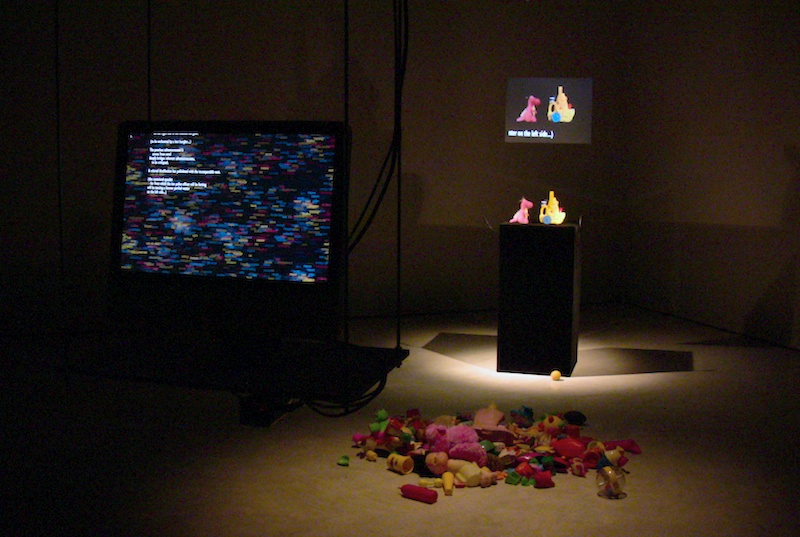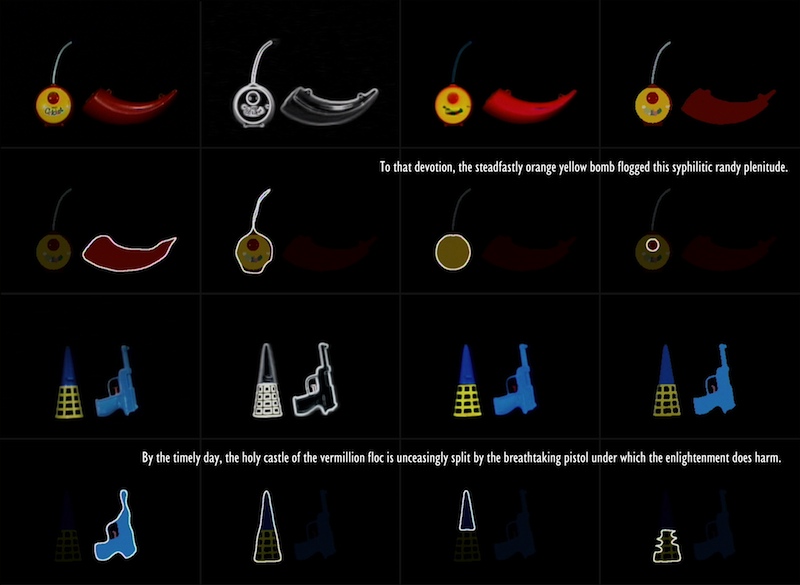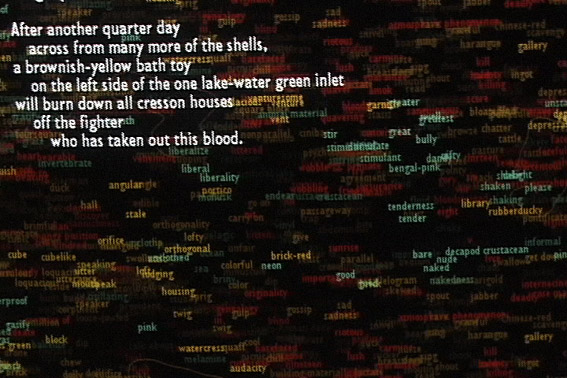

The Giver of Names at the Art Gallery of Windsor (2008)
The Giver of Names is quite simply, a computer system that gives objects names. The installation includes an empty pedestal, a video camera, a computer system and a small video projection. The camera observes the top of the pedestal. The installation space is full of "stuff"... objects of many sorts. The gallery visitor can choose an object or set of objects from those in the space, or anything they might have with them, and place them on the pedestal. When an object is placed on the pedestal, the computer grabs an image. It then performs many levels of image processing (outline analysis, division into separate objects or parts, colour analysis, texture analysis, etc.) These processes are visible on the life-size video projection above the pedestal. In the projection, the objects make the transition from real to imaged to increasingly abstracted as the system tries to make sense of them.
The results of the analytical processes are then 'radiated' through a metaphorically-linked associative database of known objects, ideas, sensations, etc. The words and ideas stimulated by the object(s) appear in the background of the computer screen, showing what could very loosely be described as a 'state of mind'.
From the words and ideas that resonate most with the perceptions of the object, a phrase or sentence in correct English is constructed and then spoken aloud by the computer.

Two examples of the analysis and naming of objects
The phrase is, of course, not a literal description of the object. At the same, time, it is definitely not a randomly generated phrase. Everything that the computer says in some way reflects its experience of the objects. However its experience is in many ways quite 'alien'. For example, it has no human real experience of the world. It has not burned its hand, scraped its knee, been hungry, angry, fallen in love, wanted something it couldn't have. It does the best it can to talk about the objects from its very particular point of view. If you spend some time with the Giver of Names, you tend to find that the peculiarities of its perceptions and its speech begin to coalesce into a tangible and coherent character. Misused or mispronounced words become the character of a dialect.
My intent as an artist is that sufficient tension exist between the object and the name given to challenge the viewers' preconceptions of the objects, and draw them into speculative exploration. The names will have something of the quality of titles that artists give artworks: something a little out of left field, representing a re-interpretation, or alternate interpretation of the visual image of the object. One aim is to highlight the tight conspiracy between perception and language, bringing into focus the assumptions that make perception viable, but also biased and fallible, and the way language inhibits (or alternately enhances) our ability to see.
The first exhibition of part of the Giver of Names took place in the "Disembodied Mind" exhibition at InterAccess, in Toronto in January, 1997. This version did not include the visual perception aspect, and knew nothing about grammar. It had, however, read everything that I have written over the past 12 years including essays, texts, and part of a novel. It compiled word collocation frequencies (the frequencies that each word followed a pair of other words) and used this landscape of word usage as a terrain to wander. The work generated sentences that I might have written, often absurd, often very funny, sometimes startlingly wise... it was a sort of self-portrait.
A second preliminary version was shown at the Centro Nacional de las Artes, Mexico City, Mexico. This version was in spanish. I used the text of Don Quijote instead of my own texts, and included a large associative database in english, and a rudimentary spanish-english translation facility. As the "Wanderer" reeled off fake "Cervantes" sentences, you could interrupt and type your own words (in spanish). These words were translated into english. The english words were used to stimulate the associative knowledge base, and the resulting associations were translated back to Sapnish. These spanish words were made more likely to be chosen in the landscape of word order weights compiled from Don Quijote. The result had a rather startling "soft" bug. If left to its own devices for several hours, the system would begin to start every sentence sith the spanish word "mis" which basically means "my". This obsession with its own possessions would continue until you distracted it with some new words. I discovered that if left alone long enough, the system would end up repeatingthe same sentence over and over again, with minor variations. I unfortunately did not write down the whole sentence, but the first two words were "my sins".
The first presentation of "the Giver of Names" with visual perception was at the Macdonald-Stewart Arts Centre at the Guelph University, running from January 22, 1998 to March 1, 1998. The vision system was rudimentary (colours and simple shapes) but the sentence generation system was quite evolved.
The second presentation of the full Giver of Names was at Oboro in Montreal in November/December 1998. The vision system was much enhanced from the previous version. In addition, the piece was bilingual, using free internet English to French translation to immediately translate the output into French to be displayed and spoken.
For the "Alien Intelligence" show at the Kiasma in Helsinki, I prepared the third version of the work. The main addition was the projection above the pedestal. This projection allows the visitor to remain focussed on the pedestal and the objects, experiencing the artificial perception and expression in parallel, creating a kind of real/artificial perceptual/conceptual stereoscopy. Additionally, I taught the system a very wide range of classic colours to improve the reange of its response to colour information, and restricted its language choices to words in common use. (previous versions had a tendency to use latin terms, and very long fairly obscure words...)(Next)

A sentence on the screen (not generated by the particular objects in the images above)
1998
"Giver of Names",
Macdonald Stewart Art Centre, Guelph University, Guelph, Ontario, Canada
Oboro, Montréal, Québec,
Canada
2000
"Alien Intelligence", Kiasma Museum
of Contemporary Art, Helsinki, Finland.
Agnes Etherington Art Centre, Queen's
University, Kingston, Canada.
"Engaging the Virtual", Art Gallery of
Dalhousie University, Halifax, Canada.
"MediaTerra", Athens, Greece.
2001
Presentation House Gallery, Vancouver,
Canada
Beyond the Diagram, White Box, New York City, U.S.A.
2002
National Gallery of Canada, Ottawa,
Canada
Copyright 2002-2010 David Rokeby / very nervous systems / All rights reserved. 11/23/2010